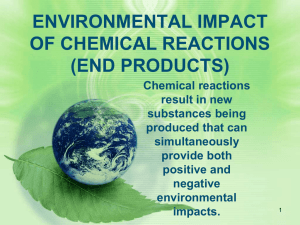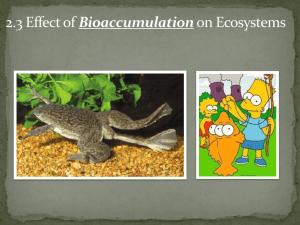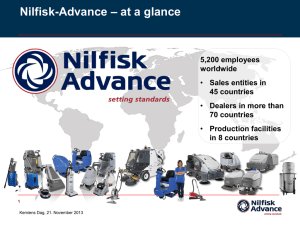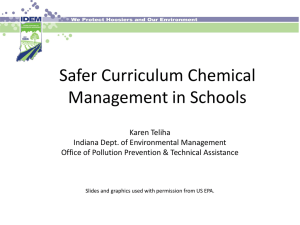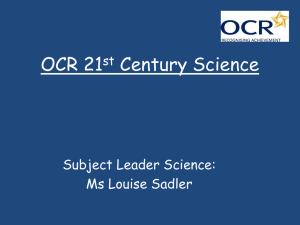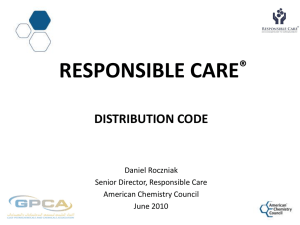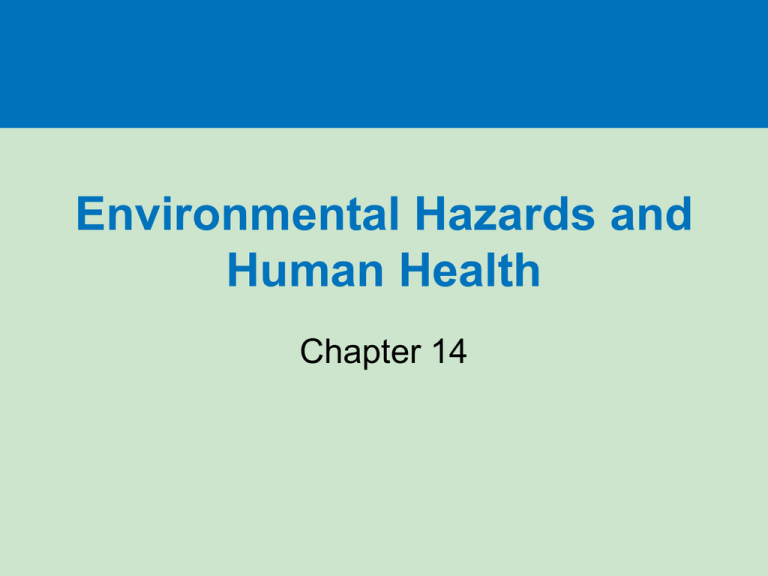
Environmental Hazards and
Human Health
Chapter 14
Three big ideas
• We face significant hazards from infectious diseases,
and from exposure to chemicals.
List examples of each (infectious and chemical)
• An ounce of (pollution) prevention is worth a pound of
cure.
Why?
• Becoming informed, thinking critically about risks, and
making careful choices can reduce the major risks we
face.
Best approach?
Section 14-1
WHAT MAJOR HEALTH
HAZARDS DO WE FACE?
Risks are usually expressed as
probabilities
• A risk is the probability of suffering harm
from a hazard that can cause injury,
disease, death, economic loss, or damage.
– Probability—a mathematical statement about
the likelihood that harm will be suffered from a
hazard.
• “The lifetime probability of developing lung cancer
from smoking one pack of cigarettes per day is 1 in
250.” This means that 1 of every 250 people who
smoke a pack of cigarettes every day will likely
develop lung cancer over a typical lifetime.
Risks are usually expressed as
probabilities
– Risk assessment is the process of using
statistical methods to estimate how much harm
a particular hazard can cause. It helps us to
establish priorities for avoiding or managing
risks.
– Risk management involves deciding whether
or how to reduce a particular risk to a certain
degree.
Risk assessment and risk
management
Section 14-2
WHAT TYPES OF BIOLOGICAL
HAZARDS DO WE FACE?
Ways infectious disease organisms
can enter the human body
Deaths per year by the 7
deadliest infectious diseases
About 47% of the population live in
areas where malaria is prevalent
Ways to prevent or reduce the
incidence of infectious diseases
Section 14-3
WHAT TYPES OF CHEMICAL
HAZARDS DO WE FACE?
Some chemicals can cause cancers,
mutations, and birth defects
• A toxic chemical is one that can cause temporary or
permanent harm or death to humans and animals.
• In 2004, the EPA listed arsenic, lead, mercury, vinyl
chloride (used to make PVC plastics), and
polychlorinated biphenyls (PCBs) as the top five toxic
substances in terms of human and environmental health.
• There are three major types of potentially toxic agents.
– Carcinogens are chemicals, types of radiation, or certain viruses
that can cause or promote cancer.
– Mutagens are chemicals or forms of radiation that cause
mutations, or changes, in the DNA molecules found in cells, or
that increase the frequency of such changes.
– Teratogens are chemicals that cause harm or birth defects to a
fetus or embryo.
PCBs and other persistent toxic
chemicals can move via many pathways
Some chemicals may affect our
immune and nervous systems
• Our body’s immune system protects us
against disease and harmful substances
by forming antibodies that render invading
agents harmless, but some chemicals
interfere with this process.
– Arsenic.
– Methylmercury.
– Dioxins.
Some chemicals may affect our
immune and nervous systems
• Some natural and synthetic chemicals in
the environment, called neurotoxins, can
harm the human nervous system, causing
the following effects.
– Behavioral changes.
– Learning disabilities.
– Retardation.
– Attention deficit disorder.
– Paralysis.
– Death.
Some chemicals may affect our
immune and nervous systems
• Examples of neurotoxins.
– PCBs.
– Methylmercury.
– Arsenic.
– Lead.
– Certain pesticides.
Ways to prevent or control
inputs of mercury pollution
Some chemicals affect the
human endocrine system
• The endocrine system is a complex network
of glands that release tiny amounts of
hormones that regulate human:
– Reproduction.
– Growth.
– Development.
– Learning ability.
– Behavior.
Some chemicals affect the
human endocrine system
• Hormonally active agents (HAA) are synthetic
chemicals that disrupt the endocrine system in
humans and some other animals.
– Examples include aluminum, Atrazine™ and
several other herbicides, DDT, PCBs, mercury ,
phthalates, and bisphenol A (BPA).
– Some disrupt the endocrine system by
attaching to estrogen receptor molecules.
– Thyroid disrupters cause growth, weight, brain,
and behavioral disorders.
Some chemicals affect the
human endocrine system
– BPA is found in plastic water bottles, baby bottles and
the plastic resins line food containers.
• Studies found that low levels of BPA cause numerous
problems such as brain damage, early puberty, prostate
cancer, breast cancer, and heart disease.
• Studies funded by the chemical industry found no
evidence or only weak evidence, for adverse effects from
low-level exposure to BPA in test animals.
• In 2008, the FDA concluded that BPA in food and drink
containers does not pose a health hazard.
• In 2010, Canada classified BPA as a toxic chemical and
banned its use in baby bottles, and the EU voted to ban
the sale of plastic baby bottles that contain BPA.
Some chemicals affect the
human endocrine system
– Phthalates are found in detergents, perfumes,
cosmetics, deodorants, soaps, and shampoo,
and in PVC products such as toys, teething
rings, and medical tubing used in hospitals.
• Phthalates cause cancer and other health problems
in laboratory animals.
Section 14-4
HOW CAN WE EVALUATE
CHEMICAL HAZARDS?
Many factors determine the harmful
health effects of chemicals
• Toxicology is the study of the harmful effects of
chemicals on humans and other organisms.
– Toxicity is a measure of the harmfulness of a
substance.
– Any synthetic or natural chemical can be harmful if
ingested in a large enough quantity.
– The dose is the amount of a harmful chemical that a
person has ingested, inhaled, or absorbed through
the skin.
– Many variables can affect the level of harm caused by
a chemical.
• Toxic chemicals usually have a greater effect on fetuses,
infants, and children than on adults.
Many factors determine the harmful
health effects of chemicals
• Toxicity also depends on genetic makeup, which determines
an individual’s sensitivity to a particular toxin.
• Some individuals are sensitive to a number of toxins—a
condition known as multiple chemical sensitivity (MCS).
• How well the body’s detoxification systems (such as the liver,
lungs, and kidneys) work.
• Solubility: water-soluble toxins and oil- or fat-soluble toxins.
• Persistence, or resistance to breakdown such as DDT and
PCBs.
• Biological magnification, in which the concentrations of some
potential toxins in the environment increase as they pass
through the successive trophic levels of food chains and
webs.
Many factors determine the harmful
health effects of chemicals
• The damage to health resulting from
exposure to a chemical is called the
response.
– Acute effect is an immediate or rapid harmful
reaction ranging from dizziness and nausea to
death.
– Chronic effect is a permanent or long-lasting
consequence (kidney or liver damage, for
example) of exposure to a single dose or to
repeated lower doses of a harmful substance.
Scientists use live laboratory animals and
non-animal tests to estimate toxicity
• The most widely used method for determining
toxicity is to expose a population of live
laboratory animals to measured doses of a
specific substance under controlled conditions.
• Lab mice and rats are widely used because their
systems function somewhat like human systems.
– Results plotted in a dose-response curve.
– Determine the lethal dose.
– Median lethal dose (LD50) is the dose that can kill
50% of the animals (usually rats and mice) in a test
population within an 18-day period.
Hypothetical dose-response
curve for LD50
Toxicity ratings and average lethal doses
for humans
Are trace levels of toxic
chemicals harmful?
• Almost everyone is now exposed to potentially
harmful chemicals that have built up to trace levels
in their blood and in other parts of their bodies.
• In most cases, we do not know if we should be
concerned about trace amounts of various synthetic
chemicals because there is too little data and
because of the difficulty of determining the effects of
exposures to low levels of these chemicals.
• Possible potential long-term effects on the human
immune, nervous, and endocrine systems.
• The risks from trace levels may be minor.
Potentially harmful chemicals
found in many homes
Why do we know so little about the
harmful effects of chemicals?
• All methods for estimating toxicity levels and risks
have serious limitations.
• Only 10% of the 80,000+ registered synthetic
chemicals in commercial use have been thoroughly
screened for toxicity, and only 2% have been
adequately tested to determine whether they are
carcinogens, mutagens, or teratogens.
• Because of insufficient data and the high costs of
regulation, federal and state governments do not
supervise the use of nearly 99.5% of the
commercially available chemicals in the US.
How far should we go in using pollution
prevention and the precautionary principle?
• Some are pushing for much greater
emphasis on pollution prevention.
• Do not release into the environment
chemicals that we know or suspect can
cause significant harm.
– Look for harmless or less harmful substitutes
for toxic and hazardous chemicals.
– Recycle them within production processes to
keep them from reaching the environment.
How far should we go in using pollution
prevention and the precautionary principle?
• In 2000, a global treaty banned or phased out the use of
12 of the most notorious persistent organic pollutants
(POPs), also called the dirty dozen. The list includes
DDT and eight other pesticides, PCBs, and dioxins.
• In 2007, the European Union enacted regulations known
as REACH (for registration, evaluation, and authorization
of chemicals) that put more of the burden on industry to
show that chemicals are safe.
– REACH requires the registration of 30,000 untested,
unregulated, and potentially harmful chemicals.
– The most hazardous substances are not approved for use if
safer alternatives exist.
– When there is no alternative, producers must present a research
plan aimed at finding one
Section 14-5
HOW DO WE PERCEIVE RISKS
AND HOW CAN WE AVOID THE
WORST OF THEM?
Estimated deaths per year in
the world from various causes
The greatest health risks come from
poverty, gender, and lifestyle choices
• The best ways to reduce one’s risk of premature
death and serious health problems are to:
– avoid smoking and exposure to smoke
– lose excess weight
– reduce consumption of foods containing cholesterol
and saturated fats
– eat a variety of fruits and vegetables
– exercise regularly
– drink little or no alcohol
– avoid excess sunlight
– practice safe sex
How key risks can shorten an
average life span
Difference between a healthy
lung and one with emphysema
Estimating risks from
technologies is not easy
• The more complex a technological system,
and the more people needed to design and
run it, the more difficult it is to estimate the
risks of using the system.
• The overall reliability or the probability that a
person, device, or complex technological
system will complete a task without failing is
the product of:
– Technology reliability.
– Human reliability.
Most people do a poor job of
evaluating risks
• Many people deny or shrug off the highrisk chances of death (or injury) from
voluntary activities they enjoy, such as:
– Motorcycling (1 death in 50 participants).
– Smoking (1 in 250 by age 70 for a pack-a-day
smoker)
– Hang gliding (1 in 1,250).
– Driving (1 in 3,300 without a seatbelt and 1 in
6,070 with a seatbelt).
Most people do a poor job of
evaluating risks
• Some of these same people may be terrified
about their chances of being killed by:
–
–
–
–
–
–
–
–
A gun (1 in 28,000 in the United States).
Flu (1 in 130,000).
Nuclear power plant accident (1 in 200,000).
West Nile virus (1 in 1 million).
Lightning (1 in 3 million).
Commercial airplane crash (1 in 9 million).
Snakebite (1 in 36 million).
Shark attack (1 in 281 million).
Most people do a poor job of
evaluating risks
• Five factors can cause people to be being more
or less risky than experts judge.
–
–
–
–
Fear.
Degree of control we have.
Whether a risk is catastrophic instead of chronic.
Some people suffer from optimism bias, the belief that
risks that apply to other people do not apply to them.
– Many risky things are highly pleasurable and give
instant gratification.
Several principles can help us
evaluate and reduce risk
• Compare risks.
• Determine how much risk you are willing
to accept.
• Evaluate the actual risk involved.
• Concentrate on evaluating and carefully
making important lifestyle choices.
Three big ideas
• We face significant hazards from infectious diseases,
and from exposure to chemicals.
• An ounce of (pollution) prevention is worth a pound of
cure.
• Becoming informed, thinking critically about risks, and
making careful choices can reduce the major risks we
face.


